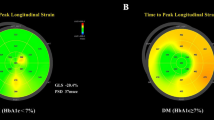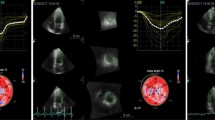Abstract
Diabetes mellitus (DM) is related to increased risks of cardiovascular diseases, such as myocardial infarction, diabetic cardiomyopathy and secondary hypertension. Dissipative energy loss (EL) derived from vector flow mapping (VFM) is thought to reflect the efficiency of blood flow and has been deemed to be an index for the evaluation of left ventricular function. Our study aimed to investigate the value of dissipative EL in diabetic patients with controlled and uncontrolled blood glucose by VFM. Eighty-eight patients with DM and 58 age-matched healthy controls were recruited. All of the patients received echocardiography examinations. VFM analyses were executed to calculate the EL values according to the apical four-chamber examinations from the left ventricle (LV) view. Our results showed that diastolic EL was compromised in the controlled-blood glucose (59.19 mV/m vs. 32.68 mV/m, p = 0.039) patients and was more dramatically increased in the uncontrolled blood glucose group (88.84 mV/m vs. 32.68 mV/m, p < 0.001) compared with the healthy controls. The impairment of systolic EL was observed only in the uncontrolled blood glucose patients (39.65 mV/m vs. 20.29 mV/m, p < 0.001) and not in the controlled blood glucose patients (29.25 mV/m vs. 20.29 mV/m, p = 0.072). Multivariate backward stepwise linear regression analysis revealed that the HbA1c level was independently related to the diastolic EL (β = 0.233, p = 0.026) and systolic EL (β = 0.237, p = 0.023). VFM is feasible and reproducible for assessing LV dissipative EL in DM patients with normal LVEF values in whom diastolic EL may be a more vulnerable indicator of early LV cardiac dysfunction in patients with DM. However, LV systolic EL may be a sensitive indicator of preclinical LV dysfunction for patients with DM with uncontrolled blood glucose levels. Uncontrolled blood glucose, which is independently correlated with subclinical LV dysfunction, may lead to increases in systolic EL and diastolic EL in LV.



Similar content being viewed by others
References
Boudina S, Abel ED (2007) Diabetic cardiomyopathy revisited. Circulation 115:3213–3223
Selvin E, Lazo M, Chen Y, Shen L, Rubin J, McEvoy JW et al (2014) Diabetes mellitus, prediabetes, and incidence of subclinical myocardial damage. Circulation 130:1374–1382
Grundy SM, Benjamin IJ, Burke GL, Chait A, Eckel RH, Howard BV et al (1999) Diabetes and cardiovascular disease: a statement for health care professionals from the American Heart Association. Circulation 100:1134–1146
Laakso M, Lehto S (1997) Epidemiology of macrovascular disease in diabetes. Diabetes Rev 5:294–315
Wild S, Roglic G, Green A, Sicree R, King H (2004) Global prevalence of diabetes: estimates for the year 2000 and projections for 2030. Diabetes Care 27:1047–1053
Ishikawa K, Chemaly ER, Tilemann L, Fish K, Ladage D, Aguero J et al (2012) Assessing left ventricular systolic dysfunction after myocardial infarction: are ejection fraction and dP/dt(max) complementary or redundant? Am J Physiol Heart Circ Physiol 302(7):H1423–H1428
Jellis CL, Stanton T, Leano R, Martin J, Marwick TH (2011) Usefulness of at rest and exercise hemodynamics to detect subclinical myocardial disease in type 2 diabetes mellitus. Am J Cardiol 107:615–624
Bergerot C, Rietzschel ER, DeBuyzere ML, Thibault H, PignonBlanc PG et al (2011) Diastolic dysfunction in patients with type 2 diabetes mellitus: is it really the first marker of diabetic cardiomyopathy? J Am Soc Echocardiogr 24:1268–1275
Bonito P, Moio N, Cavuto L, Covino G, Murena E, Scilla C et al (2005) Early detection of diabetic cardiomyopathy: usefulness of tissue Doppler imaging. Diabet Med 22:1720–1725
Aurigemma G, Battista S, Orsinelli D, Sweeney A, Pape L, Cuénoud H (1992) Abnormalleft ventricular intracavitary flow acceleration in patients undergoing aorticvalve replacement for aortic stenosis: a marker for high postoperative morbidity and mortality. Circulation 86:926–936
Bartunek J, Sys SU, Rodrigues AC, van Schuerbeeck E, Mortier L, de Bruyne B (1996) Abnormalsystolic intraventricular flow velocities after valve replacement foraortic stenosis. Mechanisms, predictive factors, and prognostic significance. Circulation 93:712–719
Chen M, Jin JM, Zhang YH, Gao Y, Liu SL (2013) Assessment of left ventricular diastolic dysfunction based on the intraventricular velocity difference by vector flow mapping. J Ultrasound Med 32:2063–2071
Muñoz DR, Markl M, Mur JLM et al (2013) Intracardiac flow visualization: current status and future directions. Eur Heart J Cardiovasc Imaging 14:1029–1038
Hayashi T, Itatani K, Inuzuka R et al (2015) Dissipative energy loss within the left ventricle detected by vector flow mapping in children: normal values and effects of age and heart rate. J Cardiol. doi:10.1016/j.jjcc.2014.12.012
Feng JL, Li ZP, Wang JR, Gao W (2011) Left ventricular flow vector characteristics and the relationship between flow vector and left ventricular systolic function in patients with anterior myocardial infarction. Zhonghua Xin Xue Guan Bing Za Zhi 39:1016–1020
Zhong Y, Liu Y, Wu T, Song H, Chen Z, Zhu W et al (2016) Assessment of left ventricular dissipative energy loss by vector flow mapping in patients with end-stage renal disease. J Ultrasound Med 35:965–973
Stugaard M, Koriyama H, Katsuki K et al (2015) Energy loss in the left ventricle obtained by vector flow mapping as a new quantitative measure of severity of aortic regurgitation: a combined experimental and clinical study. Eur Heart J Cardiovasc Imaging 16:723–730
American Diabetes Association (2010) Standards of medical care in diabetes—2010. Diabetes Care 33:S11–S61
Garcia D, del Alamo JC, Tanne D et al (2010) Two-dimensional intraventricular flow mapping by digital processing conventional color-Doppler echocardiography images. IEEE Trans Med Imaging 29:1701–1713
Itatani K, Okada T, Uejima T et al (2013) Intraventricular flow velocity vector visualization based on the continuity equation and measurements of vorticity and wall shear stress. Jpn J Appl Phys 52:07–16
Marwick TH (2004) Tissue Doppler imaging for evaluation of myocardial function in patients with diabetes mellitus. Curr Opin Cardiol 19:442–446
Vitarelli A, Sardella G, Roma AD, Capotosto L, De Curtis G, D’Orazio S et al (2012) Assessment of right ventricular function by three-dimensional echocardiography and myocardial strain imaging in adult atrial septal defect before and after percutaneous closure. Int J Cardiovasc Imaging 28:1905–1916
Marwick TH (2008) Diastolic disturbances in diabetes mellitus. Diastol Heart Fail. doi:10.1007/978-1-84628-891-3_19
von Bibra H, Sutton MSJ (2010) Diastolic dysfunction in diabetes and the metabolic syndrome: promising potential for diagnosis and prognosis. Diabetologia 53:1033–1045
Karamitsos TD, Karvounis HI, Didangelos T, Parcharidis GE, Karamitsos DT (2008) Impact of autonomic neuropathy on left ventricular function in normotensive type 1 diabetic patients: a tissue Doppler echocardiographic study. Diabetes Care 31:325–327
Fang ZY (2004) Diabetic cardiomyopathy: evidence, mechanisms and therapeutic implications. Endocr Rev 25:543–567
O’Rourke MF (2001) Diastolic heart failure, diastolic left ventricular dysfunction and exercise intolerance. J Am Coll Cardiol 38:803–805
Heerebeek L, Hamdani N, Handoko L et al (2008) Diastolic stiffness of the failing heart: importance of fibrosis, advanced glycation endproducts and myocyte resting tension. Circulation 117:43–51
Young ME, McNulty P, Taegtmeyer H (2002) Adaptation and maladaptation of the heart in diabetes. II. Potential mechanisms. Circulation 105:1861–1870
Brownlee M (2005) The pathophysiology of diabetic complications—a unifying mechanism. Diabetes 54:1615–1625
American Diabetes Association (2012) Standards of medical care in diabetes—2012. Diabetes Care 35:S11–S63
Vinereanu D, Nicolaides E, Tweddel AC, Madler CF, Holst B, Boden LE et al (2003) Subclinical left ventricular dysfunction in asymptomatic patients with typeII diabetes mellitus, related to serum lipids and glycated haemoglobin. Clin Sci 105:591–600
Andersen NH, Poulsen S, Poulsen P, Knudsen S, Helleberg K, Hansen K et al (2005) Left ventricular dysfunction in hypertensive patients with type 2 diabetes mellitus. Diabet Med 22:1218–1225
Iribarren C, Karter AJ, Go AS, Ferrara A, Liu JY, Sidney S et al (2001) Glycemic control and heart failure among adult patients with diabetes. Circulation 103:2668–2673
Grandi AM, Piantanida E, Franzetti I et al (2006) Effect of glycemic control on left ventricular diastolic function in type 1 diabetes mellitus. Am J Cardiol 97:71–76
Bibra H, Siegmund T, Ceriello A et al (2009) Optimized postprandial glucose control is associated with improved cardiac/vascular function—comparison of three insulin regimens in well controlled patients with type 2 diabetes. Hormon Metab Res 41:109–115
Wold LE, Dutta K, Mason MM et al (2005) Impaired SERCA function contributes to cardiomyocyte dysfunction in insulin resistant rats. J Mol Cell Cardiol 39:297–307
Barouch LA, Harrison RW, Skaf MW et al (2002) Nitric oxide regulates the heart by spatial confinement of nitric oxide synthase isoforms. Nature 426:337–339
Wilkinson IB, Franklin SS, Cockroft JR (2004) Nitric oxide and the regulation of large artery stiffness: from physiology to pharmacology. Hypertension 44:112–116
Funding
This study was funded by the Science & Technology Pillar Program of Sichuan Province. (Grant Number 2014SZ0004-8).
Author information
Authors and Affiliations
Corresponding author
Ethics declarations
Conflict of interest
All the authors declare that thay have no conflict of interest.
Ethical approval
All procedures performed in studies involving human participants were in accordance with the ethical standards of the institutional and/or national research committee and with the 1964 Helsinki declaration and its later amendments or comparable ethical standards.
Informed consent
Informed consent was obtained from all individual participants included in the study.
Rights and permissions
About this article
Cite this article
Li, Cm., Bai, Wj., Liu, Yt. et al. Dissipative energy loss within the left ventricle detected by vector flow mapping in diabetic patients with controlled and uncontrolled blood glucose levels. Int J Cardiovasc Imaging 33, 1151–1158 (2017). https://doi.org/10.1007/s10554-017-1100-8
Received:
Accepted:
Published:
Issue Date:
DOI: https://doi.org/10.1007/s10554-017-1100-8




